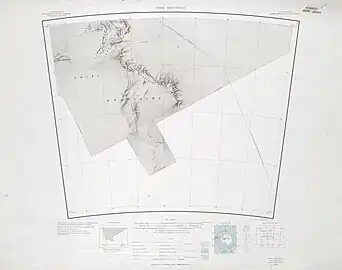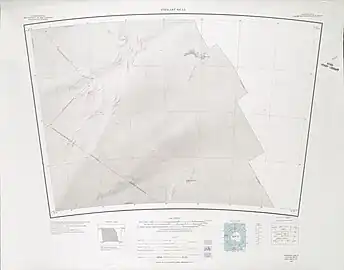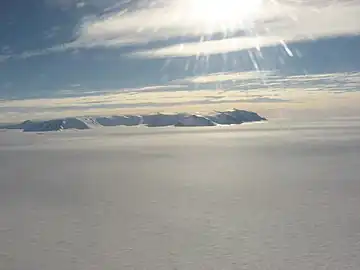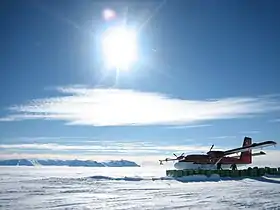| Thiel Mountains | |
|---|---|
 Aerial view of the Thiel Mountains | |
| Highest point | |
| Peak | Anderson Summit[1] |
| Elevation | 2,810 m (9,220 ft) |
| Coordinates | 85°3′S 90°51′W / 85.050°S 90.850°W |
| Dimensions | |
| Length | 72 km (45 mi) |
| Area | 71,578 km2 (27,636 sq mi) |
| Geography | |
 Thiel Mountains Location in Antarctica | |
| Continent | Antarctica |
| Region | Ellsworth Land |
| Parent range | Transantarctic Mountains |
The Thiel Mountains (85°15′S 91°00′W / 85.250°S 91.000°W) are isolated, mainly snow-capped mountains of the Transantarctic Mountains System, located in the Ellsworth Land region of Antarctica. The mountain range is 45 nautical miles (83 km; 52 mi) long, is located roughly between the Horlick Mountains and the Pensacola Mountains, and extends from Moulton Escarpment on the west to Nolan Pillar on the east. Major components include Ford Massif (2,810 metres (9,220 ft)), Bermel Escarpment and a group of eastern peaks near Nolan Pillar.[2]
Discovery and naming
The Thiel Mountains were observed and first positioned by the United States Antarctic Research Program (USARP) Horlick Mountains Traverse Party, 1958–59. They were surveyed by the United States Geological Survey (USGS) Thiel Mountains parties of 1960–61 and 1961–62. They were named by Advisory Committee on Antarctic Names (US-ACAN) after Edward C. Thiel, traverse seismologist at Ellsworth Station and the Pensacola Mountains in 1957. In December 1959, he made airlifted geophysical observations along the 88th meridian West, including work near these mountains. Thiel perished with four others in the crash of a P2V Neptune aircraft soon after take-off from Wilkes Station on November 9, 1961.[2]
Location
 Thiel Mountains
Thiel Mountains Region to the north of Thiel Mountains
Region to the north of Thiel Mountains Distant aerial view of the Thiel Mountains
Distant aerial view of the Thiel Mountains
The Thiel Mountains include the Moulton Escarpment to the northwest, which includes Chastain Peak. To the north it contains the Ford Massif. To the southeast is the Bermel Escarpment, the Davies Escarpment and Lewis Nunatak.[3] The Sontag Nunatak is some distance to the north, and the Stewart Hills are yet further north.[4]
Thiel Skiway
Thiel Skiway | |||||||||||
|---|---|---|---|---|---|---|---|---|---|---|---|
 Thiel Mountains refueling depot | |||||||||||
| Summary | |||||||||||
| Airport type | Private | ||||||||||
| Location | Thiel Mountains Ellsworth Land | ||||||||||
| Coordinates | 85°11′56″S 87°52′18″W / 85.198883°S 87.871803°W | ||||||||||
| Runways | |||||||||||
| |||||||||||
An aircraft fuel cache (85°12′S 087°53′W / 85.200°S 87.883°W) is located near the Thiel Mountains for planes traveling between the Union Glacier Camp and the Amundsen–Scott South Pole Station.[6]
Features
Moulton Escarpment
85°10′S 94°45′W / 85.167°S 94.750°W. A rock and ice escarpment, 8 nautical miles (15 km; 9.2 mi) long, in a semi-isolated position about 10 nautical miles (19 km; 12 mi) west of Ford Massif where it forms the western shoulder of the Thiel Mountains. Surveyed by the USGS Thiel Mountains party, 1960-61. Named by US-ACAN for Kendall N. Moulton of the Division of Polar Programs, National Science Foundation. As program manager of the Foundation's Field Operation Program, Moulton made more than a dozen deployments to Antarctica in the years 1958-77.[7]
Chastain Peak
85°10′S 94°35′W / 85.167°S 94.583°W. A peak, 2,255|m}}, near the center of Moulton Escarpment, at the W margin of the Thiel Mountains. Surveyed by the USGS Thiel Mountains party, 1960-61. Named by US-ACAN after William W. Chastain, Aviation Structural Mechanic, United States Navy, who lost his life in the crash of a P2V Neptune aircraft soon after takeoff from Wilkes Station, Nov. 9, 1961.[8]
Davies Escarpment
85°32′S 89°48′W / 85.533°S 89.800°W. An east-facing ice escarpment over 10 nautical miles (19 km; 12 mi) long, located southward of Bermel Escarpment in the southern part of the Thiel Mountains. The feature appears to be devoid of rock outcroppings. The name was proposed by Peter Bermel and Arthur Ford, co-leaders of the USGS Thiel Mountains party of 1960-61. Named after William E. Davies, USGS geologist aboard the icebreaker Atka in the Antarctic reconnaissance cruise of 1954-55 in search of station sites for use during the International Geophysical Year.[9]
Lewis Nunatak
85°40′S 88°05′W / 85.667°S 88.083°W. An isolated, mainly snow-covered nunatak located about 10 nautical miles (19 km; 12 mi) southeast of the Davies Escarpment and 14 nautical miles (26 km; 16 mi) southwest of Nolan Pillar, at the south end of the Thiel Mountains. The name was proposed by Peter Bermel and Arthur Ford, co-leaders of the USGS Thiel Mountains party which surveyed the area in 1960-61. Named for Charles R. Lewis, USGS geologist who worked from various U.S. vessels (Wyandot, Glacier and Eastwind) in conducting research in the McMurdo Sound region and in the Balaena Islands during the 1955-56 season.[10]
Sonntag Nunatak
84°53′S 86°42′W / 84.883°S 86.700°W. A solitary nunatak located 20 nautical miles (37 km; 23 mi) east-northeast of Hamilton Cliff, Ford Massif. The nunatak was observed on Dec. 13, 1959 by Edward Thiel and Campbell Craddock in the course of a USARP airlifted geophysical traverse along the 88th meridian West. The name was proposed by Thiel and Craddock for Wayne Sonntag, Operations Director at the Geophysical Institute, University of Wisconsin, 1959-61, logistics officer for the airlifted traverse.[11]
Stewart Hills
84°12′S 86°00′W / 84.200°S 86.000°W. Several small nunataks and snow hills rising above an otherwise featureless terrain, 50 nautical miles (93 km; 58 mi) northeast of Ford Massif. Observed by the USARP Horlick Mountains Traverse, 1958-59, and by Edward Thiel and Campbell Craddock in the course of an airlifted geophysical traverse, Dec. 13, 1959. The name was proposed by Thiel and Craddock for Prof. Duncan Stewart, geologist, Carleton College, Minnesota, whose writing and interpretation of Antarctic rock samples have contributed to knowledge of the continent.[12]
References
- ↑ Alberts 1995, p. 19.
- 1 2 Alberts 1995, p. 741.
- ↑ Thiel Mountains USGS.
- ↑ Stewart Hills USGS.
- ↑ "Thiel Skiway". Airport Nav Finder. Retrieved 17 October 2018.
- ↑ South Pole Flights
- ↑ Alberts 1995, p. 508.
- ↑ Alberts 1995, p. 131.
- ↑ Alberts 1995, p. 175.
- ↑ Alberts 1995, p. 431.
- ↑ Alberts 1995, p. 693.
- ↑ Alberts 1995, p. 713.
Sources
- Alberts, Fred G., ed. (1995), Geographic Names of the Antarctic (PDF) (2 ed.), United States Board on Geographic Names, retrieved 3 December 2023
 This article incorporates public domain material from websites or documents of the United States Board on Geographic Names.
This article incorporates public domain material from websites or documents of the United States Board on Geographic Names. - Thiel Mountains, USGS: United States Geological Survey, retrieved 17 January 2024
- Stewart Hills, USGS: United States Geological Survey, retrieved 17 January 2024
![]() This article incorporates public domain material from websites or documents of the United States Geological Survey.
This article incorporates public domain material from websites or documents of the United States Geological Survey.
.svg.png.webp)